Phidget Control Panel: Difference between revisions
| Line 13: | Line 13: | ||
[[File:RFIDReadWrite_Example.jpg|link=|alt=Windows Control Panel Example]] | [[File:RFIDReadWrite_Example.jpg|link=|alt=Windows Control Panel Example]] | ||
In the above screenshot, the RFID example was opened. These examples are intended for demonstration and debugging purposes. If you have not yet already, please see the '''Getting Started''' guide for your device, which is found in its [[:Category:UserGuide|user guide]]. It is important to keep in mind that when an example Phidget application is opened from the Phidget Control Panel or opened from any of your Phidget applications that you develop, it holds a lock on the Phidget. This prevents any other program from accessing the Phidget. Please ensure that this example application is closed (the Phidget Control Panel itself can still be running) | In the above screenshot, the RFID example was opened. These examples are intended for demonstration and debugging purposes. If you have not yet already, please see the '''Getting Started''' guide for your device, which is found in its [[:Category:UserGuide|user guide]]. It is important to keep in mind that when an example Phidget application is opened from the Phidget Control Panel or opened from any of your Phidget applications that you develop, it holds a lock on the Phidget. This prevents any other program from accessing the Phidget. Please ensure that this example application is closed (the Phidget Control Panel itself can still be running) before running your own applications. | ||
====Updating Firmware==== | ====Updating Firmware==== | ||
Revision as of 21:04, 17 March 2017
The Phidget Control Panel is a tool that can be used to quickly determine whether your system is able to communicate with Phidgets, and also acts as a testing and debugging tool. You can also update the firmware of attached devices, manage Phidget Dictionary entries, and remotely open and test Phidgets over the Phidget Network Service.
Windows
Once the Phidget libraries are installed using the installer, you should see the ![]() icon in the taskbar. Double click on it to bring up the Phidget Control Panel. If the icon does not appear, just find and open the Phidget Control Panel from the start menu.
icon in the taskbar. Double click on it to bring up the Phidget Control Panel. If the icon does not appear, just find and open the Phidget Control Panel from the start menu.
Phidgets Tab
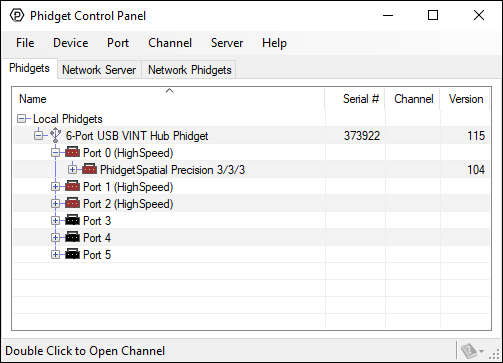
The Phidgets tab shows the list of Phidgets currently physically attached to the computer and their firmware version. It also lists the serial number that can be used in software to open a specific Phidget when more than one of the same type are connected at once. You can double click on a Phidget device in the Phidget Control Panel to open up an example program for the device.
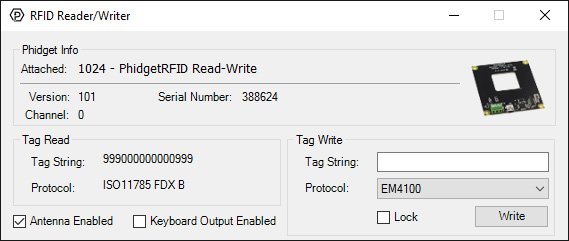
In the above screenshot, the RFID example was opened. These examples are intended for demonstration and debugging purposes. If you have not yet already, please see the Getting Started guide for your device, which is found in its user guide. It is important to keep in mind that when an example Phidget application is opened from the Phidget Control Panel or opened from any of your Phidget applications that you develop, it holds a lock on the Phidget. This prevents any other program from accessing the Phidget. Please ensure that this example application is closed (the Phidget Control Panel itself can still be running) before running your own applications.
Updating Firmware
If a Phidget shows up in red on the list in the Phidgets tab, it means the firmware is out of date. Double click on the Phidget to be given an option to apply the update. If you choose not to update, you can still use the control panel example afterwards.
Logging
To aid in debugging issues a new feature has been added as of the August 20, 2013 release. The Phidget Control Panel will now have an additional check box at the bottom, to enable logging make sure it is checked.

Now, when the UI opens for whatever device you are using it will generate information that gets stored to a file. It will show errors, unusual behaviour, and a slew of other data that is helpful for debugging problems.

Click the "View Logs" link to go to the folder where the log files are stored.
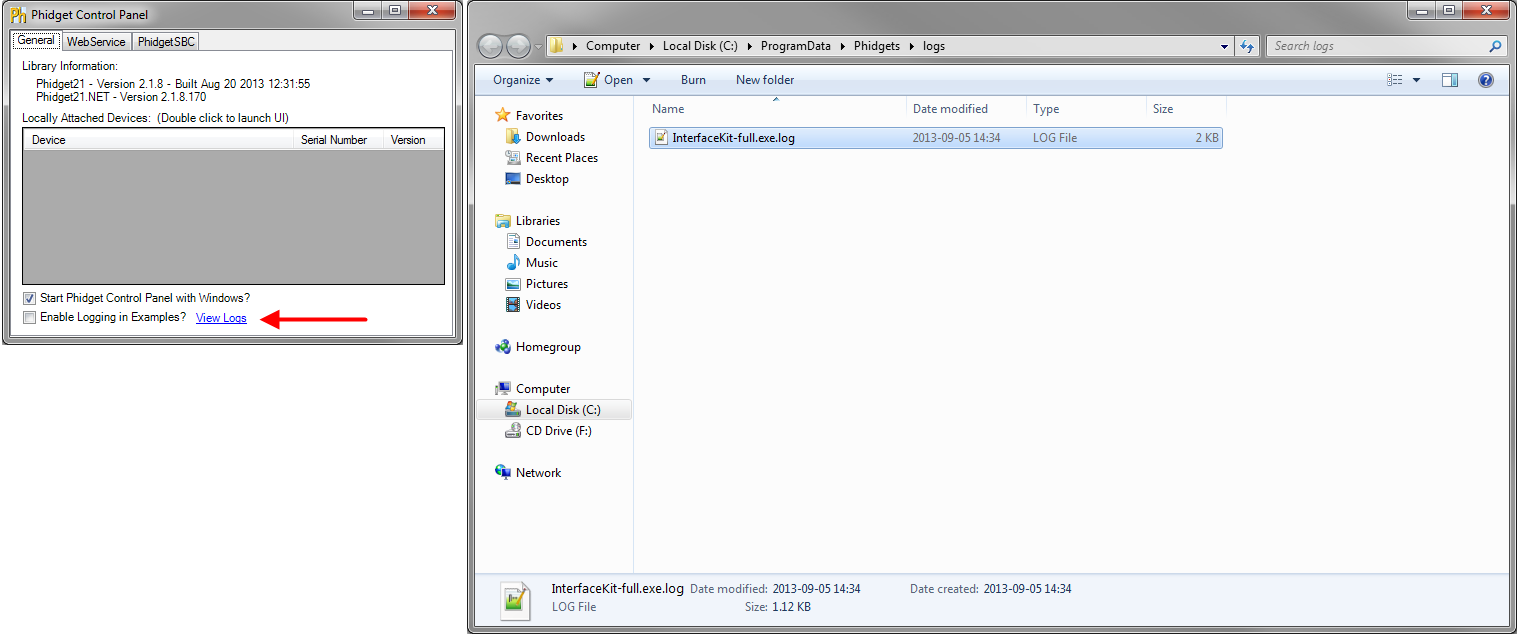
Webservice Tab
The next tab is the WebService tab, which allows you to control Phidgets over a network. There are four sub-tabs. The first sub-tab is the Setup tab.
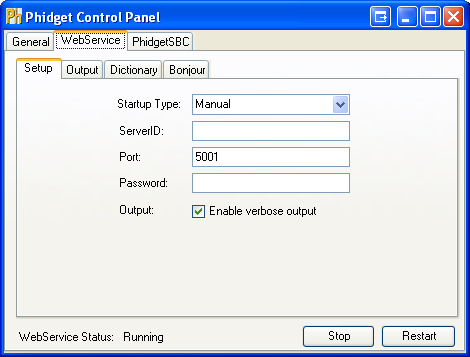
Here, you can start and stop the WebService. Details are provided in the WebService section. You can determine whether the Phidget WebService is currently running by checking the status at the bottom of the window. There is also a check box that you can select to turn on verbose output, which will display useful troubleshooting information for the WebService.
The next sub-tab is the Output tab, which provides useful debugging information while you are using the WebService. This tab will only show up if the verbose output option is selected in the previous tab.
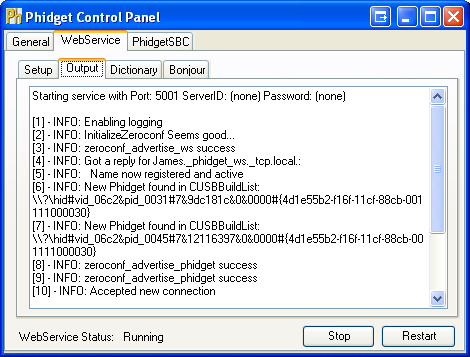
The Dictionary sub-tab comes next; it lists all the key-value pairs that gets created when the WebService runs. More information is provided in the Dictionary section of the General Phidget Programming page.
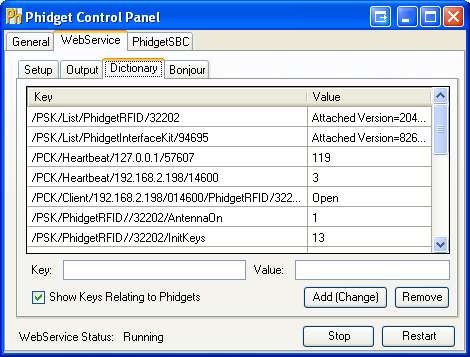
The Bonjour sub-tab gives a list of all currently attached Phidgets that are connected to the WebService. This tab will only appear if you have Bonjour installed onto your system. You can also double click on the Phidget to connect to it over the network using one or more computers, but still use the Phidget on the computer it is directly connected to.
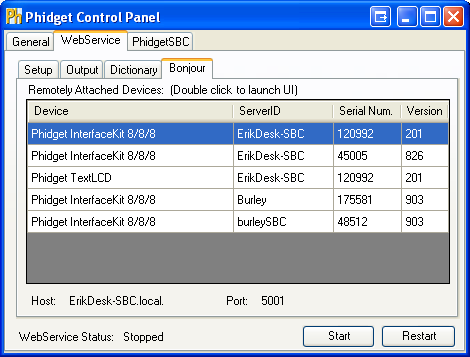
PhidgetSBC Tab
The last tab is the PhidgetSBC tab, which displays the complete list of any PhidgetSBCs connected to the network. This tab will be enabled if you have Bonjour installed onto your system.
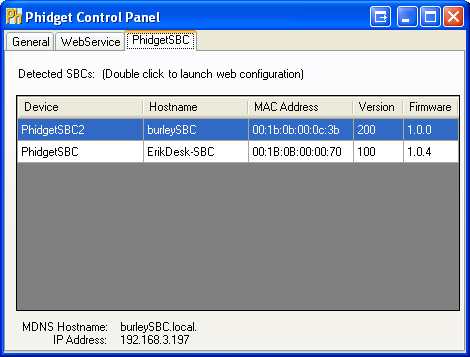
You can double click on the PhidgetSBC to bring up the PhidgetSBC Administration Console log-in page in your default browser.
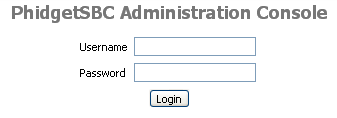
The PhidgetSBC Administration Console is where you can go to configure the PhidgetSBC. For more details, please see the PhidgetSBC section.
OS X
Once the Phidget libraries are installed using the installer, open up the System Preferences window.
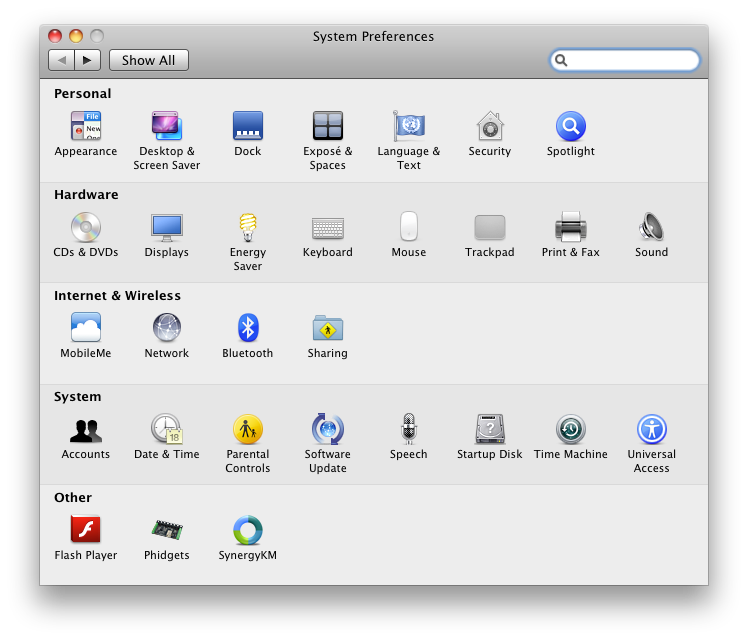
Click on the Phidgets icon in the Other section to bring up the Phidgets Preference Pane.
General Tab
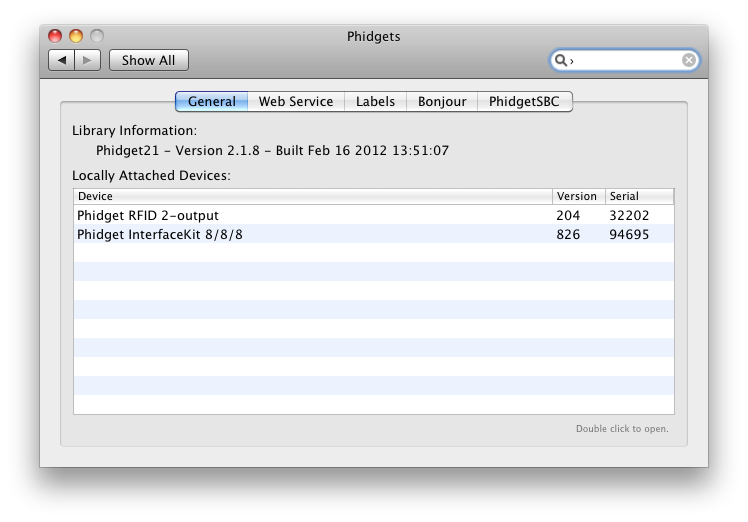
The general tab shows the list of Phidgets currently physically attached to the computer. You can also view the currently installed Phidget library version. You can double click on a Phidget device to open up an example program for the device.
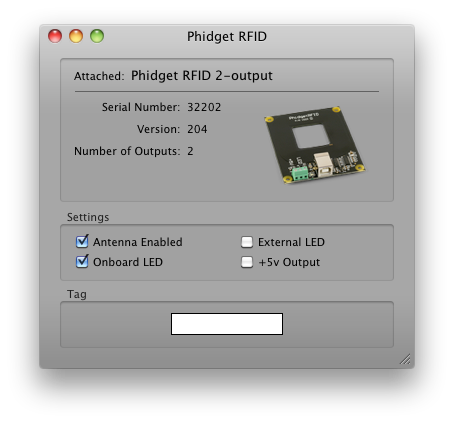
In the above screenshot, the RFID example was opened. These examples are intended for demonstration and debugging purposes. If you have not yet already, please see the Getting Started guide for your device, which may be found in its user guide.
It is important to keep in mind that when an example Phidget application is opened from the Phidget Preference Pane or opened from any of your Phidget applications that you develop, it holds a lock on the Phidget. This prevents any other program from accessing the Phidget. Please ensure that this example application is closed(the Phidget Preference Pane can still be running) when you are running your own applications.
Updating Firmware
If a Phidget shows up in red on the list in the general tab, it means the firmware is out of date. Double click on the Phidget to be given an option to apply the update. If you choose not to update, you can still use the example program afterwards.
Web Service Tab
The next tab is the Web Service tab, which allows you to control Phidgets over a network.

Here, you can start and stop the WebService. Details are provided in the WebService section. This screen also tells you whether the Phidget WebService is currently running.
Labels Tab
The next tab is the Labels tab. In this section, you can view the currently assigned labels of any Phidget attached to your computer. It is also possible to set the labels of Phidgets here too. You might want to set a label to a Phidget device because you can refer to it by its label as opposed to its serial number.

You can also view the labels of any Phidget connected through the WebService. You cannot change the label of a Phidget connected to a Windows computer, because of the way the Windows USB drivers are programmed.
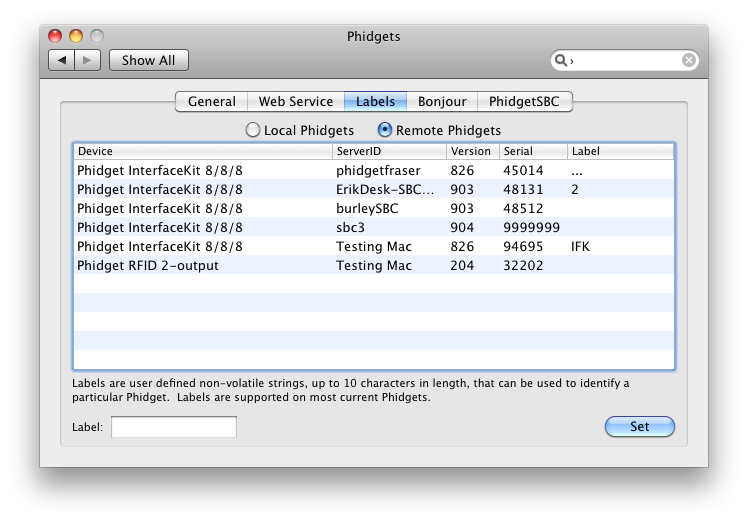
Bonjour Tab
The Bonjour tab gives a list of all currently attached Phidgets that are connected to the WebService. You can also double click on the Phidget to connect to it over the network using one or more computers, but still use the Phidget on the computer it is directly connected to.
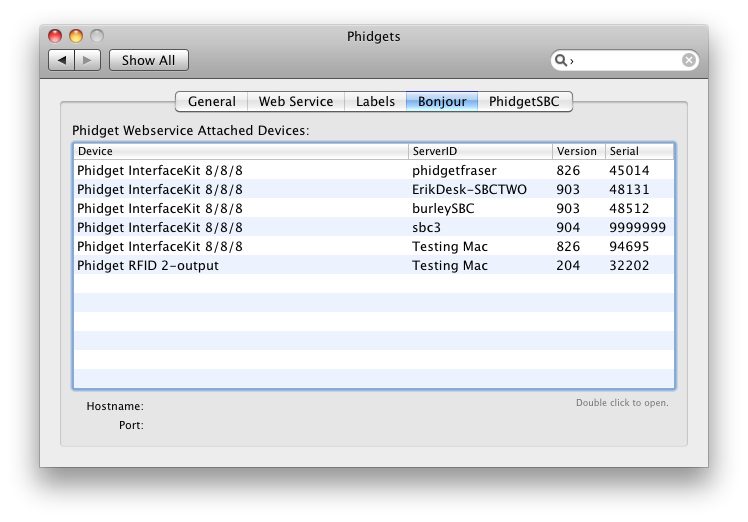
PhidgetSBC Tab
The last tab is the PhidgetSBC tab, which displays the complete list of PhidgetSBCs connected to the network.
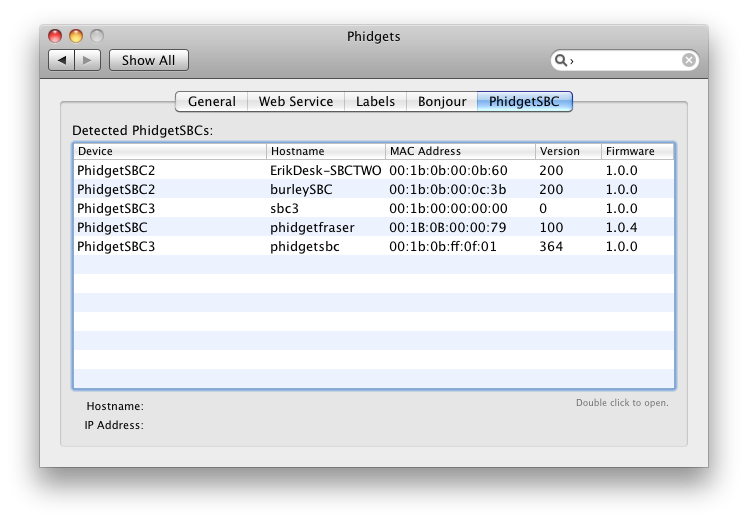
You can double click on the PhidgetSBC to bring up the PhidgetSBC Administration Console log-in page in your default browser.

The PhidgetSBC Administration Console is where you can go to configure the PhidgetSBC. For more details, please see the PhidgetSBC section.
Linux
There is no graphical interface like the control panel or preferences pane on Linux.
See the OS - Linux page for more information on how to get started with Phidgets on Linux.
